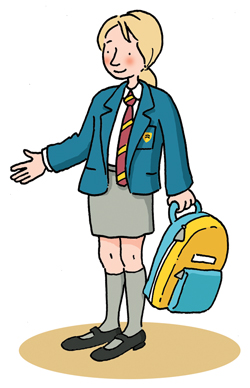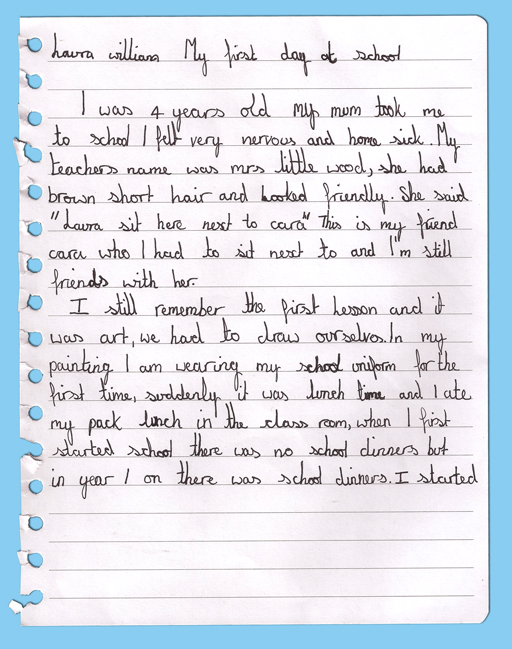3.1 From home to school
We probably all vividly remember our first day at primary school. The case study below introduces you to Lowri and her memories of her first day at school.
Case study _unit2.3.1 Case study: Lowri’s first day at primary school

Lowri is 11. She looks back on her experiences of her first important transition from home to school. This was firstly a horizontal transition, as it involved a physical move literally from one place to another. But it was also a vertical transition, as it involved a change of experience, a moving ‘up’ into primary school.
In Figure 7, Lowri remembers her first day at school and the feelings she had about being left in a strange setting. Her teacher played an important role in making the transition easier for Lowri. The detail with which she remembers the day shows how memorable the experience was to a young child of 4.

For young children, the vertical transition from home to school will most likely also involve a change in carer, such as from mother to teacher. For older children, the move from primary to secondary school will also involve changes in routine, such as having to move around the school to different classrooms for all the different subjects being studied. For many children, moving to secondary school can mean a further change in friendship groups, as children are often allocated to different schools depending on catchment areas or by parental choice.
Activity 6 asks you to identify and reflect on transitions in your early life.
Activity _unit2.3.1 Activity 6
Part 1
The three types of transition are:
- horizontal transitions
- vertical transitions
- education-associated transitions.
Bearing these in mind, think back to your childhood and identify times when you experienced these transitions. Make a note of the transitions that made the most impact on your life, making sure you include your age at the time of the transition.
Horizontal transitions
Vertical transitions
Education-associated transitions
Comment
It is most likely that you will have identified the transition of starting school or leaving school. You may have identified when you moved house or moved to a different country as a horizontal transition. Starting Cubs or Brownies, or leaving them, may have left you with strong memories of vertical transition.
Part 2
Choose one vertical transition to reflect back on. Identify others such as adults, siblings or friends who supported you during this transition.
- How did you feel before and after the transition?
- What role (positive or negative) did other people play?
- How could the experience have been made better?
Comment
What words have you used to describe how you felt: excited, nervous, fearful or a combination of these things? Children today are still experiencing these emotions as they approach and go through transitions in their lives.
Were you able to remember and make a note of the people who helped you through these changes? Sometimes this person may have been another child, an older sibling or a friend with a confident outlook on life.
Teaching assistants play a key role in helping children settle into a new setting, as they make the transition from one school to another.
